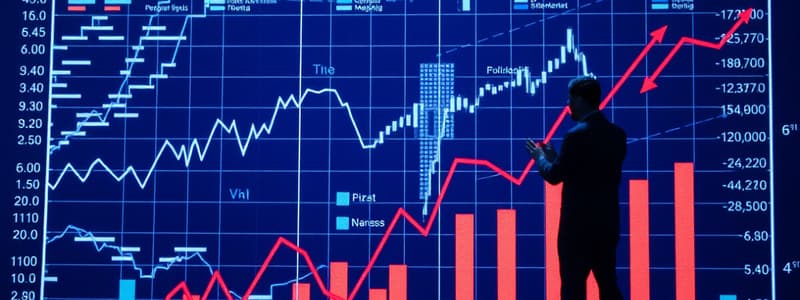Podcast
Questions and Answers
Macroeconometric models exclusively focus on microeconomic factors.
Macroeconometric models exclusively focus on microeconomic factors.
False (B)
Policymakers utilize macroeconometric models to forecast the effects of policy changes on the economy.
Policymakers utilize macroeconometric models to forecast the effects of policy changes on the economy.
True (A)
The main goal of macroeconometric models is to study individual market trends.
The main goal of macroeconometric models is to study individual market trends.
False (B)
Gross Domestic Product (GDP) is a primary indicator of economic health and growth.
Gross Domestic Product (GDP) is a primary indicator of economic health and growth.
Macroeconometric models incorporate various economic variables to analyze their interrelationships.
Macroeconometric models incorporate various economic variables to analyze their interrelationships.
Inflation represents the rate at which prices for goods and services are falling.
Inflation represents the rate at which prices for goods and services are falling.
Macroeconometric models are only used in academic research and have no applications in policy-making.
Macroeconometric models are only used in academic research and have no applications in policy-making.
Macroeconometric models are used only for analyzing historical economic data.
Macroeconometric models are used only for analyzing historical economic data.
Variables in macroeconometric models can be endogenous or exogenous.
Variables in macroeconometric models can be endogenous or exogenous.
Understanding macroeconometric models is essential for those interested in economic research.
Understanding macroeconometric models is essential for those interested in economic research.
The unemployment rate measures the percentage of the labor force that is employed.
The unemployment rate measures the percentage of the labor force that is employed.
Central banks use macroeconometric models to simulate the impact of policy changes on inflation only.
Central banks use macroeconometric models to simulate the impact of policy changes on inflation only.
High unemployment can lead to lower consumer spending, which can reduce GDP growth.
High unemployment can lead to lower consumer spending, which can reduce GDP growth.
The foundational concepts of macroeconometric models have remained unchanged throughout history.
The foundational concepts of macroeconometric models have remained unchanged throughout history.
Equations in macroeconometric models are unrelated to economic theories.
Equations in macroeconometric models are unrelated to economic theories.
Rapid GDP growth can sometimes lead to inflationary pressures.
Rapid GDP growth can sometimes lead to inflationary pressures.
Flashcards are hidden until you start studying
Study Notes
Understanding Macroeconometric Models
- Macroeconometric models analyze economic data using statistical techniques for insights into economies.
- These models clarify the relationships among key indicators like GDP, inflation, and unemployment.
- Knowledge of macroeconometric models is vital for economic policy, financial markets, and research.
Purpose and Significance
- Primary function: Understand and predict overall economic behavior.
- Models simulate the impact of changes in one economic sector on the entire economy.
- Central banks use these models to forecast monetary policy effects on inflation and growth.
- Governments evaluate fiscal policies, like tax cuts or spending increases, through these models.
- In academic research, economists test theories and analyze historical data with macroeconometric models.
Key Concepts
- Gross Domestic Product (GDP): Total value of goods/services produced in a country over a time period; indicates economic health.
- Inflation: The rate of price level increases for goods/services; central banks aim to keep it stable.
- Unemployment Rate: The percentage of the workforce that is unemployed yet actively seeking jobs; reflects labor market conditions.
- These concepts interrelate; for instance, high unemployment can decrease consumer spending, subsequently lowering GDP growth.
Components of Macroeconometric Models
- Variables: Economic indicators analyzed by the model (e.g., GDP, inflation, unemployment). Can be endogenous (determined by the model) or exogenous (outside influences).
- Equations: Mathematical relationships defining interactions among variables, grounded in economic theory or empirical data.
Studying That Suits You
Use AI to generate personalized quizzes and flashcards to suit your learning preferences.



